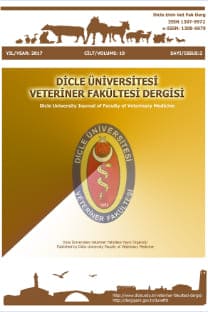Yılanlarda Soğuk Ortam Tekniği ile Tüm Vücut Silikon Plastinasyonu
Plastinasyon; örnek içerisindeki doku sıvılarının, organik bir solvent aracılığıyla, reaktif bir polimer ile yer değiştirmesidir. Bilindiği üzere soğuk ortam silikon plastinasyonunun 5 temel aşaması vardır. Bu aşamalar plastine edilecek preparatın anatomik ve histolojik özelliklerine göre değiştirilebilir veya modifiye edilebilir. Sürüngen örneklerinin hazırlanması ve uzun süre muhafazasının sağlanabilmesi, güvenilir bir anatomik metot, teknik beceri ve deneyim gerektirir. Bu bağlamda plastinasyonun amaca uygun bir yöntem olarak öne çıkmasına rağmen, pullu sürüngenlerin plastinasyonu üzerine kurgulanmış makaleler oldukça yetersizdir. Bu çalışmanın amacı; pullu sürüngenlerin soğuk ortam tekniğiyle tüm vücut silikon plastinasyonunu detaylarıyla değerlendirmek, memeli ve sürüngen plastinasyon prosedürlerini birbiriyle karşılaştırmaktır. Ayrıca pullu sürüngenlerin plastinasyonu için bir protokol oturtmak da amaçlanmıştır. Bu çalışma için iki adet tatlı su yılanı ile iki adet karayılan kullanılmıştır. Örnekler sırasıyla kısa süreli fiksasyon, dehidrasyon, impregnasyon ve gaz kürleme-sertleştirme işlemlerine tabi tutulmuş, yağdan arındırma aşaması temel adımlardan biri olmasına rağmen uygulanmamıştır. Her aşamada sıcaklık, konsantrasyon, süre gibi parametreler düzenli olarak kaydedilmiştir. Örneklerin doğal morfolojik özelliklerini koruması ve derinin doğal rengini kaybetmemesi için kısa süreli formalin fiksasyonu tercih edilmiştir. Deri renginin biraz kararmasına rağmen bu fiksasyon tekniğinin amaca uygun olduğu düşünülmüştür. Dehidrasyon aşamasında 2 defa uygulanan aseton banyosu yeterli görülmüştür. İmpregnasyon süreci beklenenden kısa sürede tamamlanmıştır. Plastine edilen örneklerin sadece elastik değil, aynı zamanda sürüngen anatomisi derslerinde kullanılabilecek kadar dayanıklı olduğu görülmüştür.
Anahtar Kelimeler:
Anatomi, plastinasyon, sürüngen, yılan.
Whole Body Silicone Plastination of Snakes with Cold-Temperature Technique
The main principle of the plastination is to replace the tissue fluids in the specimen with a reactive polymer through the medium of an organic solvent. Low temperature silicone plastination has 5 main steps as is known. However these steps can be changed or modified depending on the anatomical or histological features of the specimen. Preparation and long-time preservation of reptile specimens need virtuosity, experience and a steady anatomic method either. Plastination can be a convenient alternative for that. However, studies based on the plastination of the squamata are quite insufficient. The aim of this study was to evaluate the lowtemperature whole body silicone plastination of scaled reptiles in detailed manner and to compare the plastination procedures of reptiles and the other mammals. It is also aimed to create a protocol for the silicone plastination of squamata. Two freshwater snakes and two blacksnakes were used for this study. Samples were processed to the short-term formalin fixation, dehydration, impregnation, and gas curing-hardening procedures respectively. Although defatting is in the standard procedure of plastination, this stage was skipped. The specified parameters such as temperature, time or concentration were recorded regularly in each step. We preferred short term formalin fixation for the specimens to preserve the natural colour and the morphology. Although the colour of the skin became a bit darker, the short term formalin fixation was considered as efficient. Two times of acetone bath was satisfying for the dehydration stage. Silicone impregnation stage took short period of time than expected. Plastinated specimens were not only elastic but also durable enough to use as teaching materials in the reptile anatomy lectures of our faculty
Keywords:
Anatomy, plastination, reptile, snake.,
- ISSN: 1307-9972
- Yayın Aralığı: Yılda 2 Sayı
- Başlangıç: 2008
- Yayıncı: Dicle Üniversitesi Veteriner Fakültesi
